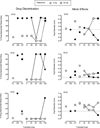Mu opioid mediated discriminative-stimulus effects of tramadol: an individual subjects analysis
- PMID: 25664525
- PMCID: PMC4596260
- DOI: 10.1002/jeab.137
Mu opioid mediated discriminative-stimulus effects of tramadol: an individual subjects analysis
Abstract
Drug discrimination procedures use dose-dependent generalization, substitution, and pretreatment with selective agonists and antagonists to evaluate receptor systems mediating interoceptive effects of drugs. Despite the extensive use of these techniques in the nonhuman animal literature, few studies have used human participants. Specifically, human studies have not routinely used antagonist administration as a pharmacological tool to elucidate the mechanisms mediating the discriminative stimulus effects of drugs. This study evaluated the discriminative-stimulus effects of tramadol, an atypical analgesic with monoamine and mu opioid activity. Three human participants first learned to discriminate 100 mg tramadol from placebo. A range of tramadol doses (25 to 150 mg) and hydromorphone (4 mg) with and without naltrexone pretreatment (50 mg) were then administered to participants after they acquired the discrimination. Tramadol produced dose-dependent increases in drug-appropriate responding and hydromorphone partially or fully substituted for tramadol in all participants. These effects were attenuated by naltrexone. Individual participant records indicated a relationship between mu opioid activity (i.e., miosis) and drug discrimination performance. Our findings indicate that mu opioid activity may mediate the discriminative-stimulus effects of tramadol in humans. The correspondence of generalization, substitution, and pretreatment findings with the animal literature supports the neuropharmacological specificity of the drug discrimination procedure.
Keywords: drug discrimination; humans; miosis; naltrexone; opioids; point-distribution; tramadol.
© Society for the Experimental Analysis of Behavior.
Figures




Similar articles
-
Pharmacodynamic profile of tramadol in humans: influence of naltrexone pretreatment.Psychopharmacology (Berl). 2012 Oct;223(4):427-38. doi: 10.1007/s00213-012-2739-4. Epub 2012 May 24. Psychopharmacology (Berl). 2012. PMID: 22623016 Free PMC article. Clinical Trial.
-
Discriminative stimulus properties of morphine mediated by mu 1-opioid receptors.Eur J Pharmacol. 1995 Sep 15;284(1-2):195-8. doi: 10.1016/0014-2999(95)00440-v. Eur J Pharmacol. 1995. PMID: 8549626
-
Influence of tramadol on morphine discriminative behavior in rats.Acta Pharmacol Sin. 2000 Oct;21(10):924-6. Acta Pharmacol Sin. 2000. PMID: 11501045
-
Discriminative and analgesic effects of mu and kappa opioids: in vivo pA2 analysis.Psychopharmacol Ser. 1988;4:107-21. doi: 10.1007/978-3-642-73223-2_9. Psychopharmacol Ser. 1988. PMID: 2899316 Review.
-
Discriminative stimulus and subjective effects of opioids with mu and kappa activity: data from laboratory animals and human subjects.Psychopharmacology (Berl). 1997 Mar;130(1):14-27. doi: 10.1007/s002130050208. Psychopharmacology (Berl). 1997. PMID: 9089845 Review.
Cited by
-
Human Drug Discrimination: Elucidating the Neuropharmacology of Commonly Abused Illicit Drugs.Curr Top Behav Neurosci. 2018;39:261-295. doi: 10.1007/7854_2016_10. Curr Top Behav Neurosci. 2018. PMID: 27272070 Free PMC article. Review.
-
A Systematic Review of Laboratory Evidence for the Abuse Potential of Tramadol in Humans.Front Psychiatry. 2019 Sep 26;10:704. doi: 10.3389/fpsyt.2019.00704. eCollection 2019. Front Psychiatry. 2019. PMID: 31616329 Free PMC article.
-
Human drug discrimination: A primer and methodological review.Exp Clin Psychopharmacol. 2016 Aug;24(4):214-28. doi: 10.1037/pha0000077. Exp Clin Psychopharmacol. 2016. PMID: 27454673 Free PMC article. Review.
References
-
- Chait LD, Uhlenhuth EH, Johanson CE. The discriminative stimulus and subjective effects of phenylpropanolamine, mazindol and d-amphetamine in humans. Pharmacol Biochem Behav. 1986;24(6):1665–1672. - PubMed
-
- Cleary JP, O'Hare E, Pomonis JD, Dittel PL, Hofmeister JJ, Fritz MM, Levine AS. Discriminative stimulus effects of morphine: central versus peripheral training. Brain Res. 1999;847(1):26–31. - PubMed
-
- Colpaert FC. Drug discrimination in neurobiology. Pharmacol Biochem Behav. 1999;64(2):337–345. - PubMed
-
- Fanciullacci M, Sicuteri R, Alessandri M, Geppetti P. Buspirone, but not sumatriptan, induces miosis in humans: Relevance for a serotoninergic pupil control. Clin Pharmacol Ther. 1995;57(3):349–355. - PubMed
Publication types
MeSH terms
Substances
Grants and funding
LinkOut - more resources
Full Text Sources
Other Literature Sources
Research Materials

